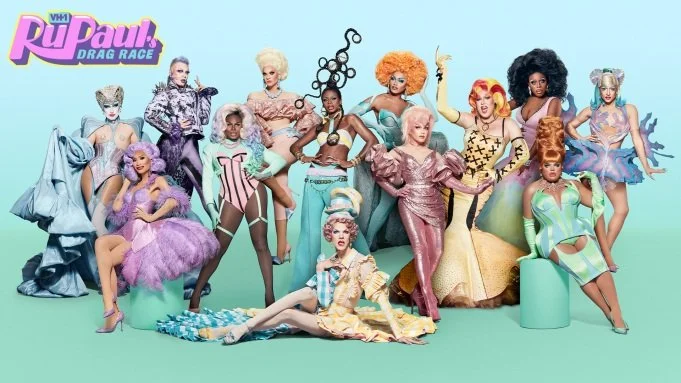The Bimini Bon Boulash Effect: The Rise of the Drag Queen in Popular Culture
BY MILLIE MANN
As contemporary society is developing to discard conservatism, traditionalism and the binary in favour of fluidity, so are its tastes. As a result of mass media and the opportunities it offers for new celebrity figures to rise through the ranks, popular culture is in constant flux. A phenomenon that has increasingly gripped mainstream audiences in recent years is the art of drag, with drag queens featuring on TV shows, in magazines and on the runway, and drag shows becoming a common fixture at both queer and non-queer venues alike. Drag offers the best of both worlds: queens often simultaneously speak to the political and social concerns of today whilst also putting on a great show – and they do it all in six inch heels.
Of course, drag is not a new art form. With origins in ancient indigenous religious ceremony, traditional Japanese theatre and male Shakespearean actors playing women’s roles, it has always been a part of culture to some extent, but only began to emerge as a more recognisable form in the late 19th and early 20th centuries, when numerous queer venues began to pop up and male performers started to put on shows in which they embodied and caricatured womanhood. In the 1980s and 90s, the Harlem drag balls and wider New York club scene became a place in which a strong queer community was cultivated, and drag performers began to gain a wide following, including stars that we may recognise today – from Divine and Lady Bunny to the institution that is RuPaul Charles.
Histories of drag throughout the late 20th and early 21st centuries tend to be quite US-centric. However, across the pond in the UK, drag has its own rich history. With performers like Lily Savage at its forefront, the UK scene was more centred towards irreverent, tongue-in-cheek comedy than the pageantry favoured by American queens. With links to the campy melodrama of pantomime, as well as the common androgynous nonconformity of punk, UK drag has always offered a unique perspective to the world.
As the popularity of drag began to grow, its iconography began to infiltrate popular culture more and more. For example, the 1990 documentary Paris is Burning featured Harlem balls, with an overwhelmingly positive response from the mainstream media. The film depicted a style of dance integral to ball culture called voguing, which was the inspiration for Madonna’s ‘Vogue’. Indeed, Princess Julia, an icon of the British underground club scene, notes that drag has long been used as a ‘creative vehicle’ in popular music, from artists like Boy George to David Bowie and, of course, Madonna.
However, it is impossible to talk about drag in popular culture without acknowledging the hit that is RuPaul’s Drag Race, to which much of drag’s rising mainstream popularity can be linked. First aired in 2009, it attained widespread acclaim following RuPaul’s Emmy nomination for the show in 2016, and has since spawned many spin-offs and even a mobile game.
The show, in all its various forms, has acted as a vessel through which counterculture has become increasingly mainstream. In fact, the show and the queens that it features have, in recent years, accumulated an ever-increasing audience of straight, cis women. While this popularisation does present issues surrounding the invasion and appropriation of queer spaces and modes of expression, it does also offer Drag Race contestants and other drag queens a wider stage on which to perform, promoting the success of queer performers and encouraging insights into queer culture where this may previously have been lacking.
Arguably the most successful spin-off of the show is its UK counterpart, RuPaul’s Drag Race UK. From its debut in 2019, Drag Race UK has offered glimpses of a more subversive side to drag. With queens such as Joe Black and Ginny Lemon from Season 2 as well as Season 3’s Charity Kase, the show has given a platform to queens who wholeheartedly embody the strange, the subversive and the punk, often inhabiting an increasingly androgynous aesthetic beyond female impersonation (despite their arguably harsh critiques from the judges and tendency for early elimination). However, one queen seems to strike the perfect balance between innovation and mass appeal: Season 2 runner-up and firm fan favourite, Bimini Bon Boulash. With a name like that, how could they not be a star!
Undoubtedly one of the biggest names in the UK scene, Bimini is an emblem of contemporary drag, maintaining the art form’s essential campiness while simultaneously turning high-fashion editorial looks and disrupting gender binaries – as a self-professed ‘cis-tem offender’. Identifying as non-binary themselves, Bimini provides an insight into drag beyond the reign of RuPaul – a drag for future generations that embraces the punk impulse for attitude and subversion, a drag that is inherently fluid – and does so on a mass scale, for consumption by a new, increasingly mainstream viewership.
Indeed, Bimini has fast become a fixture of British TV and pop culture, appearing in a wide array of notable publications, including Vogue; walking the runway at London Fashion Week; hosting an event to celebrate London’s reopening following Covid-19 restrictions with the London mayor, Sadiq Khan; even being featured in the Sainsbury’s Christmas advert as the answer in a sticky note game of ‘Who am I?’ on grandma’s head!
Even in the last month, Bimini was featured as the cover star of the GAY TIMES Honours edition, as well as being awarded the ‘Honour of Drag Hero’ by the publication.
Yet, throughout their newfound heights of success in the mainstream sphere, Bimini has maintained their punk influences and continues to advocate for the fluidity of identity and of drag as an art form, suggesting in an interview, ‘I don’t necessarily see my drag as a female illusion, I feel like it’s an extension of me’. Earlier this year, Bimini released their own book, Release the Beast: A Drag Queen’s Guide to Life, which became an instant Sunday Times bestseller (the first nonfiction text by a drag queen to achieve this feat!). The book addresses gender nonconformity in a manner free from academic jargon, focused instead on accessibility.
Nowadays, as we move further from the supposed need for binary definitions of gender and sexuality, the definition of drag is changing. More than mere female impersonation, as Bimini suggests, drag is avant-garde; drag is fashion; drag is political; drag is art. Bimini, like many of their peers, embodies the changing face of drag and, through social media and platforms such as Drag Race, presents its future to a similarly changing society which reflects this rejection of the conventional and the binary right back at them.
Drag finds its origins in community and self-expression; as previously mentioned, before it became conceived of as a stereotype, in which gay men perform caricatured femininity, it was a part of ancient tribal rites and theatre communities. In spaces such as the Harlem drag balls, it solidified its status as a mode for the celebration of queer identity, fluidity and intersectionality. As such, it makes sense for drag to continue to diversify itself to increasing degrees as it becomes more widely consumed. Some steps are being taken in the mainstream representation of drag queens, with Drag Race featuring an increasing number of transgender contestants as well as its first AFAB contestant, Victoria Scone. However, more can continue to be done.
With this notion of inclusivity in mind, it seems wrong to resist the expansion of the drag audience beyond the scope of the LGBTQ+ community, as we have seen with the rise of stars such as Bimini. In a society where labels are becoming increasingly redundant and we are moving further from a heterosexual hegemony, popular culture is changing too. While it is important to maintain a respect for the LGBTQ+ community and queer spaces, the widespread success of drag performers is a positive thing. Not only does it empower LGBTQ+ individuals, but it also offers a platform for queer perspectives where they were previously suppressed and illuminates the richness of this community.
As Bimini declares in an interview for Vogue, “There’s no destination for drag, it’s a continuous journey,” and we look forward to seeing where this space is heading!



